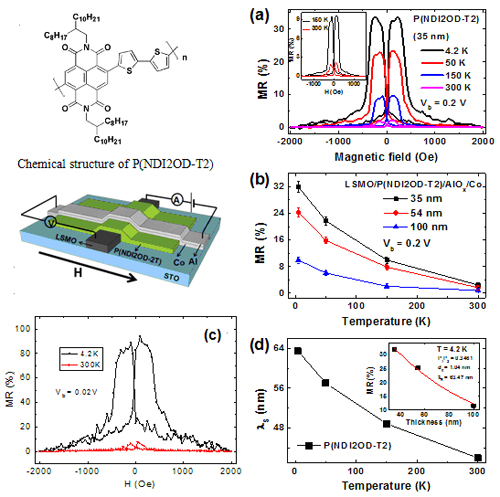Apr 08,2015|By F.P.ZHANG
The spintronic devices based on organic semiconductors (OSCs) have attracted significant attention in the past several years. Recently the investigators from High magnetic Field Laboratory (HMFL) of CAS have achieved high-performance organic spin valves (OSVs), one of basic spintronic devices, via utilizing a novel polymeric semiconductor. The relevant research results are published on Scientific Reports.
The OSCs, consisting of light elements such as carbon, hydrogen and oxygen, are characteristic of weak spin-orbit coupling and hyperfine interaction. It enables spin polarization persist a long time (i.e. spin relaxation time in a range of microseconds to milliseconds) and makes these materials as a promising spin transport medium. However, in the previous investigations organic spacers for spin-dependent transport were usually fabricated in the form of amorphous films. High structural disorder in such films leads to a very low carrier mobility. As a consequence the OSCs exhibit a rather short spin diffusion length (usually in the range of 10-50 nm), which also reduces steeply with the increased temperature. Such behavior is closely relevant to the severely low magnetoresistance (MR) effect of organic spin valves at room temperature.
A team, led by Prof. Fapei Zhang in High Magnetic Field Laboratory,CAS has utilized at the first time a polymeric semiconductor P(NDI2OD-T2) as the spin-transport spacer in the OSVs. P(NDI2OD-T2), a semi-crystalline polymer, exhibits high electron mobility and high degree of short-range order within the film. In particular the polymer takes a largely face-on molecular packing (p-stacking direction normal to the substrate), which will be favorable to charge transport in the sandwich-type devices such as spin valves. The investigators have prepared successfully high-quality and pinhole-free polymeric spin valves by low-cost spin-coating processing. They then studied the effects of the magnetic/polymer interfaces on the device performance. It is found that the introduction a 1.5-nm AlOx buffer layer between the polymer and the Co top-electrode effectively eliminates interfacial interaction and therefore enhances remarkably spin polarization of the Co electrode. Thanks to the optimization of the interface between the polymer and magnetic electrode (Co and La0.7Sr0.3MnO3), exceedingly high MR ratio of 6.8% at room temperature has been achieved, one of the highest value among the OSVs reported to date.
The investigators also evidence spin-dependent transport through the polymeric spacer via electrons injection and consequent hopping among the LUMO level of P(NDI2OD-T2). More interestingly, from the analysis of the MR data as a function of temperature and spacer thickness, P(NDI2OD-T2) is found to exhibit a large spin diffusion length with weak temperature dependence (43-60 nm), which makes the material as an excellent medium for spin- dependent transport.
P(NDI2OD-T2) is a representative of novel “donor-acceptor”(D-A) polymers, a class of recently developed high-performance OSCs. The work conducted by Prof. Zhang’s group will encourages one to explore the similar D-A polymer systems for the spintronic application, therefore paves a novel way to look for good organic spintronic materials and to develop high performance OSV in the future.
The work was supported by “Hundreds Talents Project” of CAS and National Nature Science Foundation of China.
 |
|
(a) Magneto-resistance (MR) curves for LSMO/35-nm P(NDI2OD-T2)/AlOx/Co device at different temperatures; (b) The temperature dependent MR data for the OSVs with different thickness of P(NDI2OD-T2). (c) MR ratio of the SVs via the optimization of magnetic/polymer interface (the LSMO bottom electrode was annealed at 1050 ?C before device fabrication). (d) The temperature dependence of spin diffusion length ?s of the P(NDI2OD-T2) spacer, obtained from the fitting of the MR data in Fig. b using the modified Julliere formula. |
Open access on the paper is available via: http://www.nature.com/srep/2015/150323/srep09355/full/srep09355.html.
Attachments Download:



